
Annual Bulletin 6, 1982-1983
Home
Français
Introduction
History
Annual Index
Author &
Subject
Credits
Contact

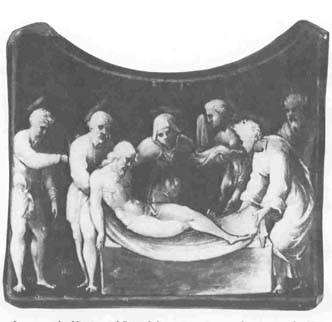
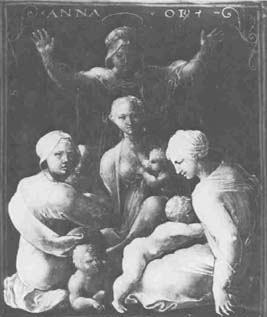
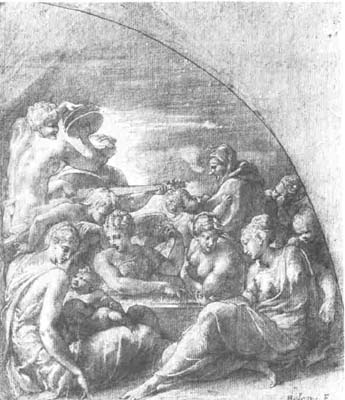
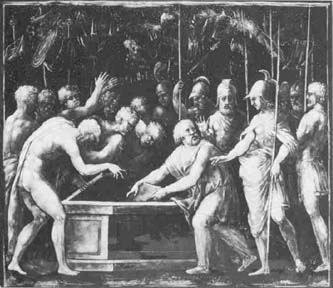
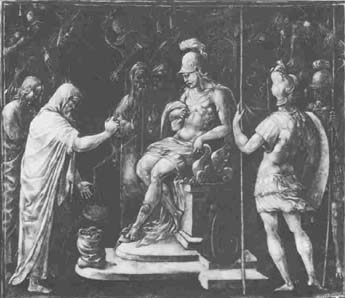
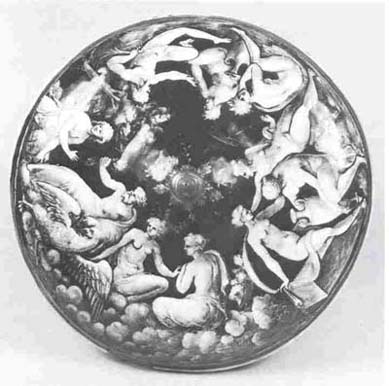
Four Sixteenth-Century Painted Enamels
by Philippe Verdier
Pages 1 | 2
| 3
| 4
| 5
A coloured-enamel Crucifixion by Jean II in the Louvre is stamped
on the reverse and initialed on the obverse, and dated 1542 (12) (fig. 5).
Christ's right hand, shown in the act of blessing, and the shining crown
of thorns bring to mind the crucifixion in the Hermitage. However, there
is the same heroic anatomy as in the Ottawa Corpus. Mary Magdalene is portrayed in a more peasant style and in her traditional pose; the contours
of her breasts can be seen under the cloth. As in medieval allegories,
the work is encumbered with banderoles bearing inscriptions of verses from
the Psalms and Isaiah announcing and foreshadowing the Crucifixion. The
shield leaning against the cross is quartered by the griffin, which surmounts the shield in the same place as on the Leningrad enamel, and indicates
a member of the Épinay family. Mary Magdalene is also shown embracing
the cross on the anonymous grisaille Crucifixion at the Walters Art Gallery,
Baltimore (13) (fig. 6). The Corpus in this work resembles the Ottawa Corpus.
The rays of light around Christ's head alternate with fleurons, which
originated in late Middle Ages' illumination work. The legs of the Virgin
and Saint John are again in very short, as in the Hermitage Crucifixion.
The Virgin seems transfixed; Saint John appears suspended in a strange
dance step. The drawing is bordered and hard, as in the enamels of Jean
II, but the outlines of the forms are blurred, though not sfumato.
In 1885, a Crucifixion signed "I. P." and stamped on the reverse,
went from the Watelin collection to the castle at GotuChow. (14) A stamped
enamel Pax showing the Crucifixion belonged, in 1908, to someone named
Pollak, according to a note by J. J. Marquet de Vasselot in the papers
he left to the Louvre. (15) The emaciated Corpus in the Hermitage enamel,
and the Virgin with clenched, intertwined fingers, and Saint John in a
striding position in the Baltimore Crucifixion, (16) are all present on one
of the ten oval grisaille medallions portraying the Passion on the base
of a monstrance or chalice ( upper part missing), at the Victoria and Albert
Museum (C. 2427-1910) (17) (fig. 7). The drapery, in curving folds and swirls,
on this Crucifixion medallion is similar to that on the Baltimore Crucifixion.
The portrayal of Saint John with dishevelled hair, and of the
holy woman with her head veiled in the Ottawa Crucifixion, resembles
the portrayal of Nicodemus and the Virgin in an entombment scene sold at
the Hôtel Drouot in Paris on 19 March 1946, and later acquired by
Gabrielle Kopelman of New York (fig. 8). This entombment scene is a grisaille
enamel executed on a rectangular plaque, cut out along the top, into which
recess originally fit the medallion portraying the Christ Child among the
scholars, at the Victoria and Albert Museum (790-1877). (18) These subjects
are arranged exactly the same way in a group of eleven scenes from the
life of Christ which border a large Ascension plaque (Hermitage Museum). (19) All the coloured enamels in this composite work bear the stamp of Jean
II Pénicaud on the reverse.
As Jennifer Godsell indicated in her doctoral thesis on Master
KIP and the Limoges grisaille enamellers, (20) defended in 1981
at Cambridge University in England, the National Gallery Crucifixion is connected with
a group of enamels in the Louvre, recognized by J. J. Marquet de Vasselot
as being from the school of Jean II Pénicaud: the Virgin and Child, the
Family of Saint Anne (fig. 9), Saint
Catherine, and Saint Jerome. (21) In the Family of Saint Anne, the figure on
the left resembles the holy woman to the left of the Virgin in the Ottawa
Crucifixion. The figure on the right (fig. 10) has the same hair style as
the Mary Magdalene in the Ottawa Crucifixion, (22) and her hand is in the
same position, with the wrist bent. The Louvre enamels and the Ottawa Crucifixion
all demonstrate the sfumato technique and feature the same physiognomy
and anatomy, analysed by Jennifer Godsell in the following way: corners
of the mouth dropping to form a "V," small pointed noses with turned-up
nostrils, slit eyes, and abnormally thin wrists.
In attributing the Ottawa Crucifixion to the school of Jean
II Pénicaud, should we assume that the author was Jean III? A large
number of grisaille enamels, most featuring a curious technique of white
gouache-like touches resembling bits of foam, have been attributed to this
enigmatic artist. In the Pénicaud dynasty, he must be the "Pénicaud
esmalheur" (enameller), referred to in documents from 1573 and 1576, at the Limoges
archives and mentioned in 1571 and 1578 as being among the consuls of Limoges.
If he was the son of Jean II, how long was he in his father's studio before
becoming an independent master? Was his first style chiaroscuro, before
the impressionistic brush touches? I have ascribed to him two enamels at
the St Louis Museum in Missouri. They clearly display the same grisaille
technique as the Crucifixion at the National Gallery. One represents Alexander
the Great having Homer's Iliad placed in a sarcophagus (fig. 11), and is
based on the grisaille fresco of Giovanni Francesco Penni in the Vatican's
Stanza della Segnatura (engraved by Marcantonio). The other work is thought
to represent Alexander before the priests of Ammon (fig. 12). (23) Like the
Ottawa Crucifixion, these two works have shadow punctuated by spears, gleams
of light, the clinging of cloth to spongy-looking bodies. On the base and
cover of a tazza enamelled in grisaille (fig. 13a), attributed
to Pierre or Jean III Pénicaud and now at the Walters Art Gallery,(24) the sfumato and gouache styles are juxtaposed. One finds again the
whinnying horse, and the centurions Roman helmet and plated chest armour
(fig. 13b) seen in the Ottawa Crucifixion. The attribution of the National
Gallery's Crucifixion to Jean III is merely a plausible hypothesis, though,
and perhaps a document, or a comparison with a signed work, will one day
make it possible to establish the artist's identity.
Next Page | "Jean
Court"
1 | 2
| 3
| 4
| 5
Annual Index | Author & Subject | Credits | Contact
This digital collection
was produced under contract to Canada's Digital Collections program,
Industry Canada.
"Digital
Collections Program, Copyright
© National Gallery of
Canada 2001"